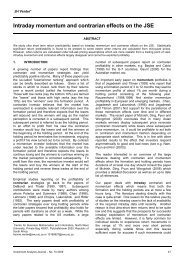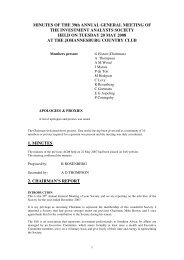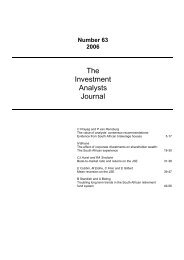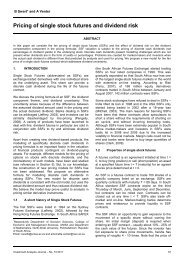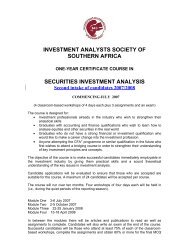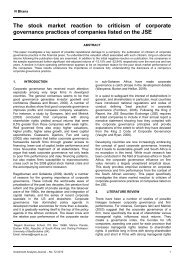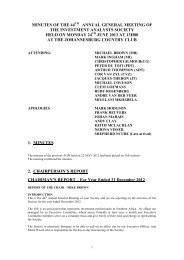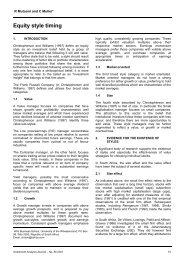The market reaction to capital expenditure announcements
The market reaction to capital expenditure announcements
The market reaction to capital expenditure announcements
You also want an ePaper? Increase the reach of your titles
YUMPU automatically turns print PDFs into web optimized ePapers that Google loves.
<strong>The</strong> <strong>market</strong> <strong>reaction</strong> <strong>to</strong> <strong>capital</strong> <strong>expenditure</strong> <strong>announcements</strong><br />
<strong>The</strong> cross-sectional analysis identified a number of<br />
significant influences on the <strong>market</strong> <strong>reaction</strong> <strong>to</strong><br />
investment <strong>announcements</strong>. <strong>The</strong> company size variable<br />
was found <strong>to</strong> be negatively related <strong>to</strong> abnormal returns<br />
and company performance was found <strong>to</strong> be positively<br />
related <strong>to</strong> abnormal returns in a number of models (see<br />
Table 3). <strong>The</strong> company focus variable was found <strong>to</strong><br />
generate significantly positive abnormal returns for<br />
project characteristics that create new growth<br />
opportunities i.e., R&D, product/<strong>market</strong> diversification,<br />
and joint ventures.<br />
<strong>The</strong> evidence presented here is more supportive of a<br />
wide range of <strong>market</strong> responses <strong>to</strong> different categories<br />
of <strong>capital</strong> investments. It seems credible that the <strong>market</strong><br />
attempts <strong>to</strong> distinguish between good and poor<br />
investment decisions as suggested by Chen et al. (1995)<br />
and also <strong>capital</strong> investments made by focused and<br />
diversified companies. <strong>The</strong> poor <strong>market</strong> response <strong>to</strong><br />
<strong>capital</strong> investments by diversified may well be attributed<br />
<strong>to</strong> the shareholder preference for “pure plays” and<br />
single-minded focus and rewarding companies that meet<br />
these criteria (Doukas and Kan, 2004). This suggests<br />
that diversified companies should review their bloated<br />
organizational structure in order <strong>to</strong> derive the maximum<br />
benefits from their <strong>capital</strong> investments. A more focused<br />
approach <strong>to</strong> company investments is also likely <strong>to</strong><br />
reduce the “diversification discount” applicable <strong>to</strong> highly<br />
diversified companies on the JSE reported by Bhana<br />
(2006).<br />
Capital investments by highly diversified companies<br />
result in sub-optimal resource allocation and nonmaximization<br />
of shareholder wealth. <strong>The</strong>se companies<br />
will become increasingly uncompetitive in a world driven<br />
by global trade. Local diversified companies should<br />
follow the example of Anglo American, South African<br />
Breweries and other former conglomerates that have<br />
become focused and world class companies in the post-<br />
1994 period. It is recommended that diversified<br />
companies seeking <strong>to</strong> become focused companies<br />
should redirect their <strong>capital</strong> investments <strong>to</strong> projects that<br />
create future growth opportunities rather than merely<br />
extending existing investment opportunities.<br />
An important finding is that the share price change<br />
associated with insider information is greater than the<br />
public information revealed at the announcement date.<br />
This paper has not investigated whether trading by<br />
company insiders plays any role in influencing the<br />
shareholder wealth related <strong>to</strong> <strong>capital</strong> <strong>expenditure</strong><br />
decisions. John and Mishra (1990) have shown that<br />
company insiders share their superior knowledge of<br />
investment opportunities through a combination of<br />
revising their investment holdings and announcing<br />
changes in <strong>capital</strong> <strong>expenditure</strong>s. <strong>The</strong>refore, a proper<br />
interpretation of <strong>capital</strong> investment <strong>announcements</strong> is<br />
conditional on a concurrent investigation of insider<br />
trading in the company‟s shares. It will be interesting for<br />
future researchers <strong>to</strong> investigate whether insider trading<br />
plays any role in the share <strong>market</strong> <strong>reaction</strong> <strong>to</strong> <strong>capital</strong><br />
<strong>expenditure</strong> <strong>announcements</strong>.<br />
REFERENCES<br />
Al-Qudah KAM.1991. Capital <strong>expenditure</strong> decisions and<br />
company <strong>market</strong> value: A study of information flows and<br />
associated share price movements. Unpublished<br />
doc<strong>to</strong>ral thesis. University of Dundee (UK).<br />
Berger P and Ofek E. 1995. Diversification‟s effect on<br />
firm value. Journal of Financial Economics, 37(1): 39-65.<br />
Bhana N. 2006. <strong>The</strong> effect of corporate divestments on<br />
shareholder wealth: <strong>The</strong> South African experience. <strong>The</strong><br />
investment Analysts Journal, 63: 19-30.<br />
Bradfield DJ and Barr GDI. 1989. Risk-estimation in the<br />
thinly traded JSE environment. South African Journal of<br />
Business Management, 20(3): 169-173.<br />
Brown SJ and Warner JB. 1985. Using daily s<strong>to</strong>ck<br />
returns: <strong>The</strong> case of event studies. Journal of Financial<br />
Economics, 14(3): 345-376.<br />
Bur<strong>to</strong>n BM, Lonie AA and Power DM. 1999. <strong>The</strong> s<strong>to</strong>ck<br />
<strong>market</strong> <strong>reaction</strong> <strong>to</strong> investment <strong>announcements</strong>: <strong>The</strong> case<br />
of individual <strong>capital</strong> <strong>expenditure</strong> projects. Journal of<br />
Business Finance & Accounting, 26(5/6): 681-709.<br />
Castle J and Kan<strong>to</strong>r B. 2000. Tracking s<strong>to</strong>cks - an<br />
alternative <strong>to</strong> unbundling for the South African group.<br />
Investment Analysts Journal, 51: 49-56.<br />
Chan SH, Martin JD and Kensinger JW. 1990. Corporate<br />
research and development <strong>expenditure</strong> and share value.<br />
Journal of Financial Economics, 26(2): 255-276.<br />
Chan SH, Gau WG, and Wang K. 1995. S<strong>to</strong>ck <strong>market</strong><br />
<strong>reaction</strong> <strong>to</strong> <strong>capital</strong> investment decisions: Evidence from<br />
business relocations. Journal of Financial and<br />
Quantitative Analysis, 30(1): 81-100.<br />
Chan SH, Kensinger JW, Keown AJ and Martin JD.<br />
1997. Do strategic alliances create value? Journal of<br />
Financial Economics, 46(1): 199-221.<br />
Chaney PK and Devinney TM. 1992. New product<br />
innovations and s<strong>to</strong>ck price performance. Journal of<br />
Business Finance & Accounting, 19(2): 677-695.<br />
62 Investment Analysts Journal – No. 68 2008




